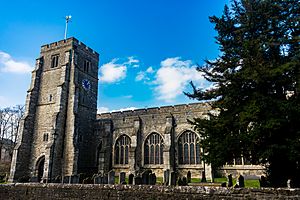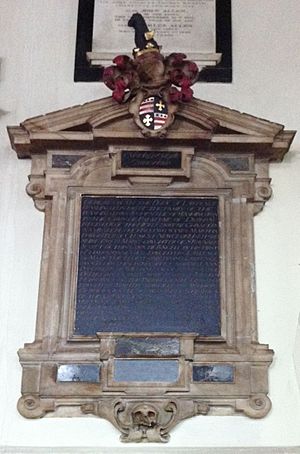All Saints Church, Maidstone facts for kids
Quick facts for kids All Saints Church |
|
|---|---|

South side of the church
|
|
| Lua error in Module:Location_map at line 420: attempt to index field 'wikibase' (a nil value). | |
| Location | Mill Street, Maidstone, Kent ME15 6YE |
| Country | England |
| Denomination | Anglican |
| Website | http://www.maidstoneallsaints.co.uk/ |
| History | |
| Status | Parish church |
| Founded | 1395 |
| Founder(s) | Archbishop William Courtenay |
| Architecture | |
| Functional status | Active |
| Heritage designation | Grade I |
| Designated | 30 July 1951 |
| Style | Perpendicular |
| Completed | 1396–1398 |
| Specifications | |
| Materials | Rag-stone |
| Bells | 10 (full circle) |
| Tenor bell weight | 32 long cwt 0 qr 20 lb (3,604 lb or 1,635 kg) |
| Administration | |
| Parish | Maidstone, All Saints with St Philip and St Stephen, Tovil |
| Deanery | Maidstone |
| Archdeaconry | Maidstone |
| Diocese | Canterbury |
| Province | Canterbury |
All Saints Church is a historic church located in Maidstone, Kent, England. It is a very important building, recognized as a Grade I listed building. This means it has special historical or architectural importance. Many people consider it the most impressive church built in the Perpendicular style in all of Kent.
Contents
How All Saints Church Began
All Saints Church was started in 1395 by Archbishop William Courtenay. He was the leader of the church in Canterbury. The church was part of a new school and religious community called the College of All Saints. It was built on the site of an older church dedicated to St Mary.
Archbishop Courtenay passed away in 1396. His replacement, Thomas Arundel, finished building the church and college between 1396 and 1398. King Richard II gave the college land and money. This money came from a hospital and from several nearby church areas. To help pay for the building, Archbishop Courtenay got special permission from the Pope. This allowed him to collect a small fee from all church income in his area.
The College Closes
In 1546, the College of All Saints was closed down. This happened because of a law called the Chantries Act. At that time, the college was earning a lot of money each year.
After the college closed, the church became separate from the college buildings. All Saints Church then became the main church for the entire town of Maidstone. The college's land was given to George Brooke. However, his grandson, Henry Brooke, lost the land in 1603. This was because he was accused of plotting against King James I. Later, during the time of King Charles I, the college buildings became the property of Sir Edward Henden. Eventually, they were owned by the family of the Earls of Romney.
Exploring the Church Building
The church stands in a small churchyard. The River Medway is to its west. Parts of the old college, like its main gate, are to the south. The Archbishop's Palace is to the north-west. The palace's large tithe barn is to the north-east. The old wall around the churchyard and a war memorial are also important historical structures.
The church is built from a type of stone called ragstone. It has strong buttresses (supports) and a crenellated top, which looks like the battlements of a castle. The tower is on the south-west side and is about 24 meters (78 feet) tall. It used to have a tall, pointed roof called a spire. But this spire was destroyed by lightning in 1730.
Inside, the church has a long main area called a nave. It has six sections and side areas called aisles on both the north and south. Above the aisles, there is a row of windows called a clerestory. On the south side, there is a special chapel. This chapel was originally used by a local religious group. Inside, you can see memorials to important people. These include Archbishop Courtenay and others who lived centuries ago.
The font, where baptisms take place, is from the early 1600s. The wooden seats in the choir area have special carvings underneath called misericords. The timber roof was replaced in 1886. This was designed by a famous architect named John Loughborough Pearson. He also designed the decorative screens and the reredos (a screen behind the altar).
The church tower has a set of ten bells. These bells are regularly rung by the church's bell-ringing group. The church clock was made in 1899. It was repaired in 2007. The clock chimes every quarter and full hour.
Today, the church building is on the Historic England Heritage at Risk Register. This means it needs special care to protect it for the future.
Church Choirs
All Saints Church has both male and female choirs. They are led by the Director of Liturgical Music. The main organist and Director of Liturgical Music is Philip Horley. Lionel Marchant is also an organist.
See also
- Grade I listed buildings in Maidstone.
- List of ecclesiastical restorations and alterations by J. L. Pearson



